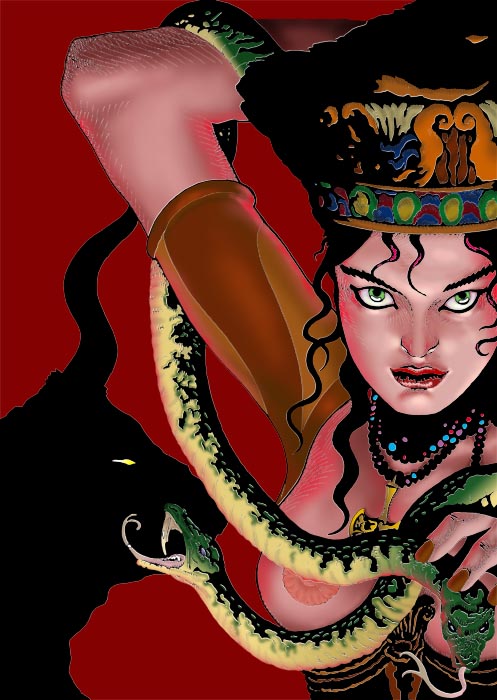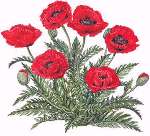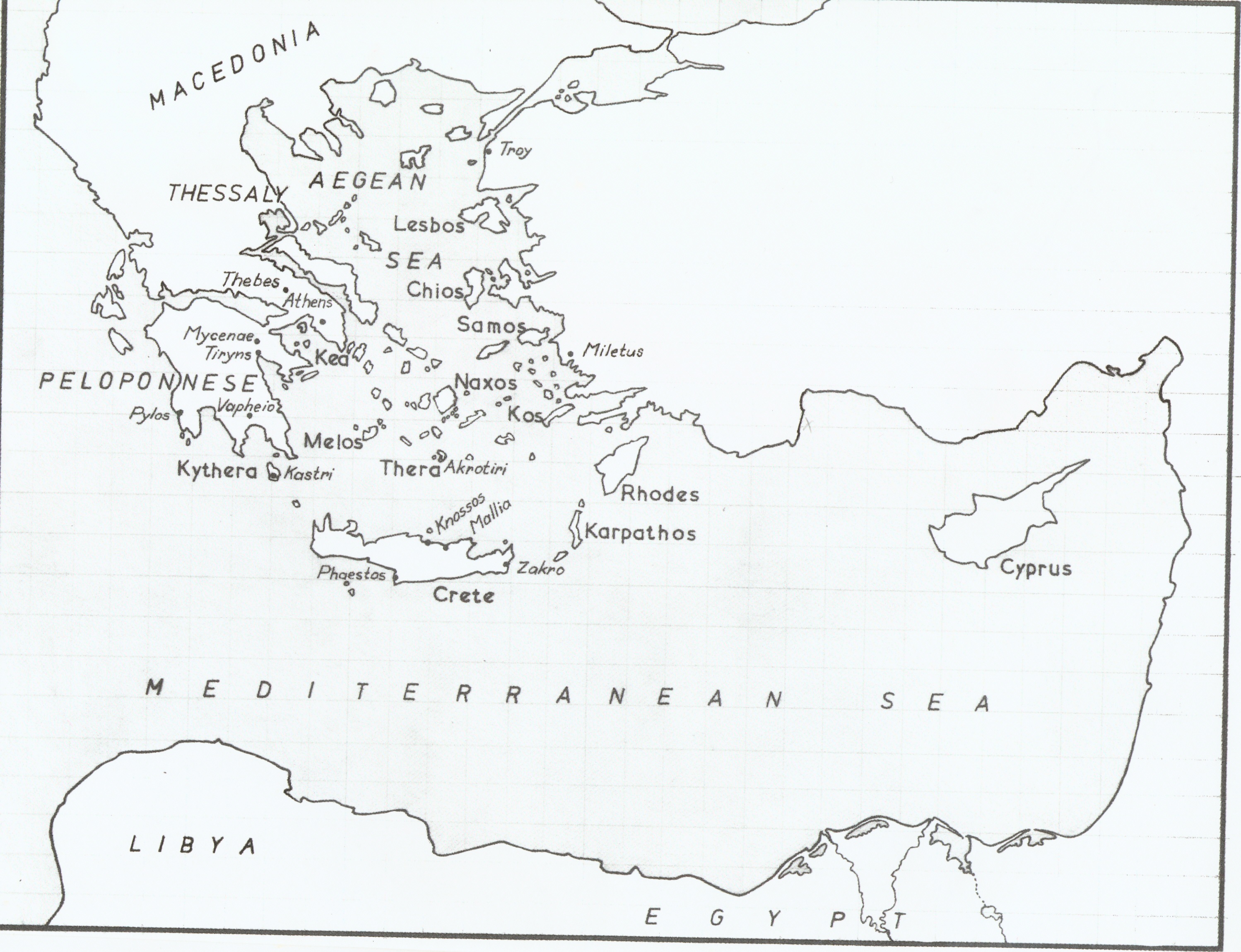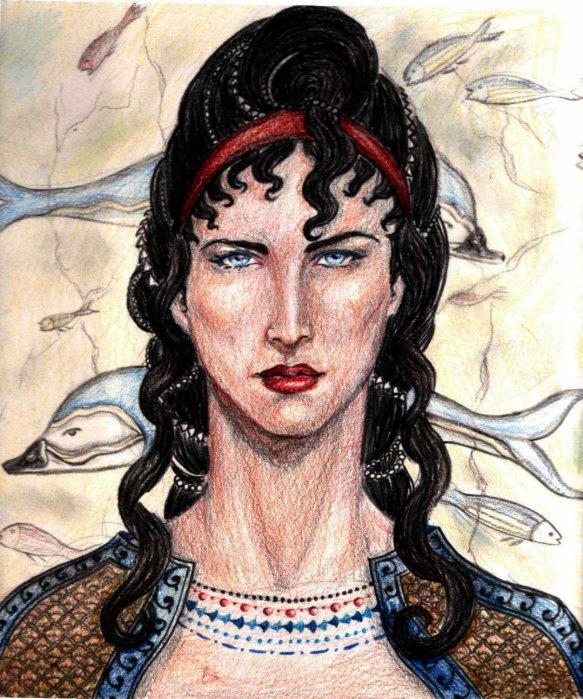Kalika
– Goddess of


Sacred Symbols –
labrys, bull horns, snake,
poppy,
breasts, caves, nature
Sacred Foods – opium,
olive oil, wine,
grain, honey
Colors – white, red,
black
Seasons – all
Aspects of Life –
birth, childbirth, death,
love. She is also connected to ecstatic
dancing
and art, especially pottery, faience, weaving and painting. Favored patterns in Cretan art included
spirals and life-like studies of plants, marine life and animals.
Animals – snake, dove,
bull, dolphin, bee,
octopus
Elements, Rocks, Metals
– clay, shells,
gypsum, gold, earth and water
Flower – poppy, trees
“Out of the dark blue
sea there lies a land
called

MODERN
Crete is a
Mediterranean island now part of
modern day
The island’s highlands
are excellent for
growing sheep and goats and the lowlands, including the massive plain,
Messara,
grow cereals, beans, olives and grapes. The
island currently grows citrus fruits, but these would not have excited
long ago
and
"Used with permission of Random House, copyright The Bodley
Head."
NEOLITHIC
Archaeologists have
found evidence of
people settling on
The early people bred
sheep and goats,
cultivated crops and fished. They lived
in mud brick houses. Gradually, they
began to make pottery and spin and weave cloth. (1, p.13)
MINOAN
Ancient Cretan history
is divided into two
significant parts, Minoan and Mycenaean.
The term Minoan is a misnomer, getting its origin from King
Minos (more
about him later).
Map of the Labyrinthine Site of Knossos
"Used with permission of Random House, copyright The Bodley Head."
During the Pre-palatial
period (from 2600
to 2000 B.C.), the people did metalwork with copper, bronze, silver,
tin and
gold. The indigenous Cretans lived
on
the island flourishing in the arts and traveling the seas, trading with
Minoan women are
depicted in art with white
skin, the men with red. The women are
bare breasted, as are statues of the Goddess.
They wore flounced skirts, corsets and jewelry.
Minoan men wore a kilt and high leather
books. They did not wear jewelry except
some had a signet ring. (1 p.21)
Minoans also practiced
an acrobatic
physical game called ‘bull leaping’ where both men and women leapt over
the
backs of bulls. Given the importance of
bulls in Minoan art, it is probably safe to conclude that bull leaping
was an
important part of ritual celebrating the cycle of life.
There is a surviving fresco depicting bull
leaping with a woman ready to leap. As
she stands in front of the massive animal, I can easily see where the
phrase
“grab the bull by the horns” originated.
And today, in
Up until 1600 B.C., the
Minoans buried
their dead with some possessions, pottery and their seals.
A man would have his tools/weapons, a woman
her jewelry. The dead were trussed into
a fetal position and buried in round stone communal tombs.
They did not practice cremation. (1, p.23)
MYCENEAN
Experts think that at
some point near 1450
B.C. the Mycenaeans, from mainland
By the time Homer wrote
the Odyssey, the
Cretan civilization had been reduced to oral histories and ruins, the
people
living in poverty compared to their previous state. (1, p.17)
GREEK MYTHS
CONCERNING
Classical Greek
mythology is full of Cretan
references. There are the several myths
surrounding Minos, a possible King or title of several Kings, including
his
claim to rule
And later, Zeus left Olympus to return to Crete when he changed himself into a bull and abducted the beautiful maiden Europa. Once Europa climbed on his back, he swam away with her from her homeland to the island of Crete. Incredibly sad, Europa lamented her kidnapping and felt consoled knowing that the entire continent of Europe would be named after her.
CLASSICAL GREEK
GODDESSES CONNECTED TO
Britomartis - the
goddess of mountains and
hunting, she is also known as Diktynna and Aphaea.
Myth tells us she was Zeus’ daughter. King
Minos relentlessly pursued her. Attempting
to escape Minos’ advances, she
ultimately threw herself off a cliff and was caught by the nets of
fisherman. Artemis made her the Goddess
Diktynna and she was the goddess of mountains, shores and ports. In another version Britomartis escaped to
The Goddess of the Sea
(Mistress of Fishes)
- appeared in Minoan art and had shrines along the Minoan shore line. She is sometimes depicted on seals and golden
rings traveling in a boat. (4) The importance of the sea is evident by a
huge fresco found at
Eileithyia – Goddess of
Childbirth. Eileithyia has a cave on
Ariadne – daughter of
Minos and
Pasiphae. She fell in love with Theseus
and promised to help him escape the great maze if he would take her
with
him. Daedalus gave her a ball string so
that Theseus could find his way out of the labyrinth.
Ariadne gave him a sword so that he could
slay the Minotaur. Theseus either left
her on the
AND WHAT THEN OF
THE ORIGINAL CRETAN GODDESS?
Very little is known
about her. She is closely associated with
the Hittite
goddess Cybele who was depicted with a panther, lion and dove. She is also closely related to Astarte in
that she is part of a regeneration cycle.
(3) Kalika’s consort, the bull,
is sacrificed and reborn each year.
| Cretan Goddess Names: |
Affiliated
Goddesses: |
| The Mother of Mountains | Atemis Cybele |
| Hunting
Goddess |
Artemis Potnia Theron |
| Goddess
of the Sacred Tree or Pillar |
Isis |
| Snake
Goddess |
Medusa Gorgons |
| Dove
Goddess |
Aphrodite |
| Poppy
Goddess |
Demeter |
| Mother
Goddess – nursing an infant |
Demeter Isis |
| Sea
Goddess – carrying weapons. |
Athena Aphrodite |
Unhappy
with men’s random name choices which tended to describe the artifact
they found
rather than the Goddess, I felt she deserved a name and was led to
choose
Kalika. Kalika is a Greek word for the
pod, bud or outer covering of a flower.
The pod is both the final phase of the flower and yet it
contains seeds,
the promise of rebirth, thus it succinctly depicts the cycle of life. Kali also means beautiful or good and is used
in contemporary Greek speech today in such phrases as:
Good morning –
pronounced as - kaleemera
Good afternoon –
pronounced as - kaleespera
Good night – pronounced
as - kaleeneekhta (5)
Other Greek Women’s
Names Include:
Kalidas – most beautiful
Kalligenia – most
beautiful daughter
Kalliroe – beautiful
stream (6)
Kalika was worshiped at
the main ‘palace’
sites of Zakro, Phaistos, Mallia and Knossos.
She was also worshipped in caves and at mountain peak shrines. Her worship included epiphany, the appearance
of the Goddess to the people, ecstatic dance, blood offerings of small
and
large animals and agricultural offerings of grain, olive oil, honey and
wine.
Her worship probably included the ingestion of opium.
15 Minute Heart/Blood
Ritual:
Clear your space and
light your
candles. Then put in your favorite dance
music. Crank it up and dance your heart
out for fifteen minutes.
Bless yourself by doing
a little
cardiovascular exercise today and everyday.
Take joy in the way your body moves.
Relish that you are alive.
When you are done, be
sure to thank the Goddess
for all that you have and hug someone you love to share your energy.
Original Work
Kalika,
Lovely Lady,
Mother to the Pantheon,
grant me appreciation
of the blessings
that encircle me.
Help me to protect
your sacred places
and be an advocate
for your animals.
Live within me
that I may face my
fears
and fiercely love
the gifts you’ve sent -
my animal companions,
my consort,
my children,
and myself.
SOURCES:
1 – “The Archaeology of
Minoan Crete” Reynold Higgins, Henry Z. Walck, Inc.,
2 – www.pantheon.org/articles/b/britomartis.html
3
– www.fhw.gr/chronos/02/crete
4
– www.pantheon.org/articles/g/goddess_of_the_sea.html
5 – “Berlitz Greek
Phrase Book”
6
– “Baby Names From Around the World” Pocket Publishing, 1991
Additional
Sources:
http://www.uk.digiserve.com/mentor/minoan/knossos.htm
(an
excellent site for photos of
Copyright 2006
